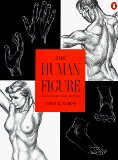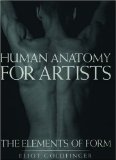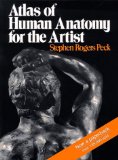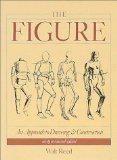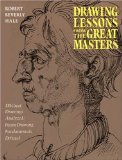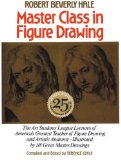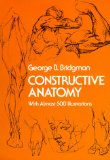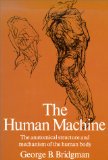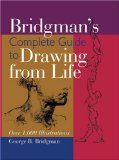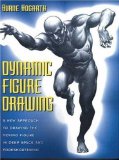Artistic anatomy is a tough discipline. It can’t be learned in a day. It took me several years and many books. You can learn anatomy from books, but buy wisely. Even if you can afford to buy books indiscriminately, you’ll still have to trudge through them (like I did) only to find that some aren’t worth the time. This is my list of my old-but-worthy favorites, with comments.
Books
The Human Figure
by David K. Rubins
Inexpensive, complete and comprehensible. One criticism: cadaverous. Even the fleshed figures look shrink-wrapped. But it shows all bones and muscles with clear, detailed illustrations. I learned anatomy primarily from this book. It has the advantage that it is printed on cheap paper that takes colored pencils so you can go through it and “color code” all the muscles. By the time you’ve gone through the whole book and colored all the deltoids red and the biceps yellow, you get familiar with their names, the fact that they exist, and where they are on the body.
I recommend George Bridgman (linked below) to counteract the stiffness of Rubins. Bridgman’s figures are expressive but hard to understand. Rubins is easy to understand, but dead-looking. You can study them both in tandem and seek to unite Rubins’ clarity and Bridgman’s strength. —mv
Click to buy from Amazon.com
Human Anatomy for Artists
by Eliot Goldfinger
An exhaustive artistic anatomy book. He uses all technical terms which makes it impossible for the beginner to understand. I got through it after having taught anatomy a dozen times, and it was slow going, so don’t start here. It is the most complete of all the “pure anatomy” textbooks for artists and once you know anatomy, you will refer back to it often for every detail. It does not teach you how to draw, so it is as applicable to sculptors as it is to draftspersons, but very valuable to all as reference. —mv
Click to buy from Amazon.com
Atlas of Human Anatomy for Artists
by Stephen Peck
This book never goes out of print. It is unlike Rubins or Goldfinger’s book in that it is not “pure anatomy.” It teaches draftsmanship of the figure as well. If you had to get one book that covers it all, this is a good choice because of it’s breadth — it includes dissection plates with detailed renderings, charts, readable text, and scores of “helpful hints” pages that are excellent for simplifying drawing problems. Not as expressive as Bridgman, but not as quirky either. In fact, like Rubins, Peck makes Bridgman’s books comprehensible. —mv
Click to buy from Amazon.com
The Figure
by Walt Reed
Reed has very unrefined anatomy, but his approach is so sound and his teaching so unpretentious that I recommend it. It is similar to Peck’s book, but easier to understand, and with less emphasis on anatomy, more on general figure drawing. This was a part of the old “Famous Artists School” mail order series that offered excellent training for beginners. —mv
Click to buy from Amazon.com
Drawing Lessons from the Great Masters
by Robert Beverly Hale
Not really an anatomy book, though it has one chapter devoted to anatomy, and it’s the best drawing book I know. A solid “ten.” 100 master drawings analyzed simply, clearly and with deep insight from a man who understood anatomical figure drawing as thoroughly as anyone in the 20th century, and who taught it as well as anyone in any century. Unfortunately, the sequel called Anatomy Lessons from the Great Masters doesn’t compare — it has great pictures but the text is lifeless reportage — Hale didn’t write it even though they used his name. —mv
Click to buy from Amazon.com
Master Class in Figure Drawing
by Robert Beverly Hale
This book is a “ten” with flaws. If you get confused, don’t blame yourself. It was taken from Hale’s lectures at the Art Students League and has at least a dozen errors because the transcriber didn’t understand the material. Still a great book — a treasure of knowledge and wisdom from the best anatomy teacher of the past hundred years. The writing is entertaining and enlightening. More than worthwhile. —mv
Click to buy from Amazon.com
Constructive Anatomy
The Human Machine
The Complete Guide to Drawing from Life
by George Bridgman
Bridgman taught Robert Beverly Hale and Norman Rockwell. His drawings are sometimes inconsistent, often sloppy and difficult for beginners to decipher, but in spite of such flaws you can learn a lot about how the forms of the figure “fit together.” Plus, they are beautiful drawings with rock-like solidity. The text does not help much. These books need a teacher to clarify the strategies and subtleties, but you may figure out some of it on your own if you study classic drawing (like from Hale) alongside Bridgman. Constructive Anatomy and The Human Machine are smaller books, easier to carry around. The Complete Guide to Drawing from Life is a compilation that gives you the best of the smaller books. —mv
Click a cover or title to buy from Amazon.com

 Bridgman’s Complete Guide to Drawing From Life, 5th Edition
Bridgman’s Complete Guide to Drawing From Life, 5th Edition
by George Bridgman
Bridgman’s Complete Guide has been around for decades. It compiles most of the best of the small books.
There was reason to whine about the Complete Guide for a few decades: flawed organization, an upside-down torso, and more than one upside-down knee, but the 5th Edition fixed the upside-down bits and slightly improved the layout information but here’s why it’s not important: nobody recommends this book for ease of understanding or train of thought.
It’s a collection of great images. Read the text as you like, but you probably won’t. He offers some excellent thoughts, but in a 100-year-old academic style that can exhaust you by the end of a paragraph.
You can get much better explanations from Robert Beverly Hale. Especially his Drawing Lessons from Great Masters, but also from Hale’s Master Class in Figure Drawing, which couples well with Bridgman because it is such enjoyable reading by comparison. Also, Hale was Bridgman’s student.
Here’s my recommendation: this book is filled with the bulk of his Bridgman’s work. Buy it to look at the pictures. —mv
Click to buy from Amazon.com
Dynamic Figure Drawing
by Burne Hogarth
Don’t try to read it — you’ll just get frustrated. Look at the pictures and you’ll learn how to use form in drawing the figure. The anatomy is stylized to the point of looking artificial — more like plastic action figures than real humans — but it is strong on showing how classic draftsmanship can be creatively applied to the human body. —mv
Click to buy from Amazon.com
Marshall is a participant in the Amazon Associates program and may earn a small commission on products purchased using these links. The product price is the same whether or not you use these links, but by using them, it helps offset the cost of running this website.
